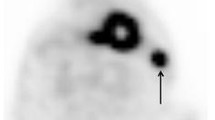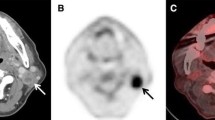Abstract
Purpose
The aim of our study was to prospectively evaluate whether intravenous contrast media in integrated positron emission tomography and computed tomography (PET/CT) with 18F-fluorodeoxyglucose (18F-FDG) significantly contributes to evaluation of primary head and neck cancers compared with unenhanced PET/CT, regional contrast-enhanced CT of head and neck (neck CE-CT) and regional magnetic resonance imaging of head and neck (neck MRI).
Methods
Subjects were 42 consecutive patients (35 men, 7 women; age range: 36–91 years) with biopsy-proven primary head and neck cancers. Lesion detection of primary and nodal sites and TNM classification were assessed on a per-patient basis. McNemar test and κ statistics were employed for statistical analyses.
Results
Forty patients (95%) were successfully followed up: 24 patients had nodal disease and 3 had distant metastasis. Contrast-enhanced and unenhanced PET/CT detected 98 and 95% of the primary tumours, respectively, and both detected 92% of patients with nodal disease, which revealed no statistically significant difference. Accuracy for T status was 75 and 73%, respectively, which proved significantly more accurate than neck CE-CT, which had an accuracy of 53% (p = 0.0133 and 0.0233, respectively). Neck MRI correctly classified the T status in 58% of patients; however, no statistically significant difference was found between PET/CT and neck MRI. Contrast-enhanced PET/CT, unenhanced PET/CT, neck CT and neck MRI correctly staged the N status in 90, 90, 79 and 90% of patients, respectively, with no statistically significant difference. Overall TNM classification was correctly classified in 68 and 65% of patients, respectively. Weighted κ values between enhanced and unenhanced PET/CT for primary tumour detection, nodal detection, T status and N status were 0.655, 1.000, 0.935 and 1.000, respectively.
Conclusion
We found almost perfect correlation between enhanced and unenhanced PET/CT for lesion detection and initial staging of primary head and neck cancers. Routine contrast administration for PET/CT imaging may not be justified.


Similar content being viewed by others
References
Argiris A, Karamouzis MV, Raben D, Ferris RL. Head and neck cancer. Lancet 2008;371:1695–709. doi:10.1016/S0140-6736(08)60728-X.
Dammann F, Horger M, Mueller-Berg M, Schlemmer H, Claussen CD, Hoffman J, et al. Rational diagnosis of squamous cell carcinoma of the head and neck region: comparative evaluation of CT, MRI, and 18FDG PET. AJR Am J Roentgenol 2005;184:1326–31.
Veit-Haibach P, Luczak C, Wanke I, Fischer M, Egelhof T, Beyer T, et al. TNM staging with FDG-PET/CT in patients with primary head and neck cancer. Eur J Nucl Med Mol Imaging 2007;34:1953–62. doi:10.1007/s00259-007-0564-5.
Nakamura T, Sumi M. Nodal imaging in the neck: recent advances in US, CT and MR imaging of metastatic nodes. Eur Radiol 2007;17:1235–41. doi:10.1007/s00330-006-0490-0.
Stokkel MP, Terhaard CH, Hordijk GJ, van Rijk PP. The detection of local recurrent head and neck cancer with fluorine-18 fluorodeoxyglucose dual-head positron emission tomography. Eur J Nucl Med 1999;26:767–73. doi:10.1007/s002590050448.
Kresnik E, Mikosch P, Gallowitsch HJ, Kogler D, Wiesser S, Heinisch M, et al. Evaluation of head and neck cancer with 18F-FDG PET: a comparison with conventional methods. Eur J Nucl Med 2001;28:816–21. doi:10.1007/s002590100554.
Zanation AM, Sutton DK, Couch ME, Weissler MC, Shockley WW, Shores CG. Use, accuracy, and implications for patient management of [18F]-2-fluorodeoxyglucose-positron emission/computerized tomography for head and neck tumors. Laryngoscope 2005;115:1186–90. doi:10.1097/01.MLG.0000163763.89647.9F.
Fleming AJ Jr, Smith SP Jr, Paul CM, Hall NC, Daly BT, Agrawal A, et al. Impact of [18F]-2-fluorodeoxyglucose-positron emission tomography/computed tomography on previously untreated head and neck cancer patients. Laryngoscope 2007;117:1173–9. doi:10.1097/MLG.0b013e31805d017b.
Connell CA, Corry J, Milner AD, Hogg A, Hicks RJ, Rischin D, et al. Clinical impact of, and prognostic stratification by, F-18 FDG PET/CT in head and neck mucosal squamous cell carcinoma. Head Neck 2007;29:986–95. doi:10.1002/hed.20629.
von Schulthess GK, Steinert HC, Hany TF. Integrated PET/CT: current applications and future directions. Radiology 2006;238:405–22. doi:10.1148/radiol.2382041977.
Endo K, Oriuchi N, Higuchi T, Iida Y, Hanaoka H, Miyakubo M, et al. PET and PET/CT using 18F-FDG in the diagnosis and management of cancer patients. Int J Clin Oncol 2006;11:286–96. doi:10.1007/s10147-006-0595-0.
Czernin J, Allen-Auerbach M, Schelbert HR. Improvements in cancer staging with PET/CT: literature-based evidence as of September 2006. J Nucl Med 2007;48:78S–88S.
Kitajima K, Murakami K, Yamasaki E, Domeki Y, Kaji Y, Fukasawa I, et al. Performance of integrated FDG-PET/contrast-enhanced CT in the diagnosis of recurrent ovarian cancer: comparison with integrated FDG-PET/non-contrast-enhanced CT and enhanced CT. Eur J Nucl Med Mol Imaging 2008;35:1439–48. doi:10.1007/s00259-008-0776-3.
Rodríguez-Vigil B, Gómez-León N, Pinilla I, Hernández-Maraver D, Coya J, Martín-Curto L, et al. PET/CT in lymphoma: prospective study of enhanced full-dose PET/CT versus unenhanced low-dose PET/CT. J Nucl Med 2006;47:1643–8.
Goerres GW, Schuknecht B, Schmid DT, Stoeckli SJ, Hany TF. Positron emission tomography/computed tomography for staging and restaging of head and neck cancer: comparison with positron emission tomography read together with contrast-enhanced computed tomography. Clin Imaging 2008;32:431–7. doi:10.1016/j.clinimag.2008.04.012.
Ng SH, Yen TC, Liao CL, Chang JT, Chan SC, Ko SF, et al. 18F-FDG PET and CT/MRI in oral cavity squamous cell carcinoma: a prospective study of 124 patients with histologic correlation. J Nucl Med 2005;46:1136–43.
Green FL, Page DL, Fleming ID, et al. AJCC cancer staging manual. 6th ed. New York, NY: Springer; 2002.
Kundel HL, Polansky M. Measurement of observer agreement. Radiology 2003;228:303–8. doi:10.1148/radiol.2282011860.
Jeong HS, Baek CH, Son YI, Chung M, Kyung Lee D, Young Choi J, et al. Use of integrated 18F-FDG PET/CT to improve the accuracy of initial cervical nodal evaluation in patients with head and neck squamous cell carcinoma. Head Neck 2007;29:203–10. doi:10.1002/hed.20504.
Branstetter BF 4th, Blodgett TM, Zimmer LA, Snyderman CH, Johnson JT, Raman S, et al. Head and neck malignancy: is PET/CT more accurate than PET or CT alone? Radiology 2005;235:580–6. doi:10.1148/radiol.2352040134.
Jones AS, Morar P, Phillips DE, Field JK, Husband D, Helliwell TR. Second primary tumors in patients with head and neck squamous cell carcinoma. Cancer 1995;75:1343–53. doi:10.1002/1097-0142(19950315)75:6<1343::AID-CNCR2820750617>3.0.CO;2-T.
Caldemeyer KS, Mathews VP, Righi PD, Smith RR. Imaging features and clinical significance of perineural spread or extension of head and neck tumors. Radiographics 1998;18:97–110.
Yoo GH, Hocwald E, Korkmaz H, Du W, Logani S, Kelly JK, et al. Assessment of carotid artery invasion in patients with head and neck cancer. Laryngoscope 2000;110:386–90. doi:10.1097/00005537-200003000-00010.
Fung K, Lyden TH, Lee J, Urba SG, Worden F, Eisbruch A, et al. Voice and swallowing outcomes of an organ-preservation trial for advanced laryngeal cancer. Int J Radiat Oncol Biol Phys 2005;63:1395–9. doi:10.1016/j.ijrobp. 2005.05.004.
Genden EM, Ferlito A, Rinaldo A, Silver CE, Fagan JJ, Suárez C, et al. Recent changes in the treatment of patients with advanced laryngeal cancer. Head Neck 2008;30:103–10. doi:10.1002/hed.20715.
Acknowledgments
This research was supported in part by a Grant-in-Aid for Young Scientists B 19790888 from the Ministry of Education, Culture, Sports, Science and Technology, Japan.
Author information
Authors and Affiliations
Corresponding author
Rights and permissions
About this article
Cite this article
Yoshida, K., Suzuki, A., Nagashima, T. et al. Staging primary head and neck cancers with 18F-FDG PET/CT: is intravenous contrast administration really necessary?. Eur J Nucl Med Mol Imaging 36, 1417–1424 (2009). https://doi.org/10.1007/s00259-009-1127-8
Received:
Accepted:
Published:
Issue Date:
DOI: https://doi.org/10.1007/s00259-009-1127-8




